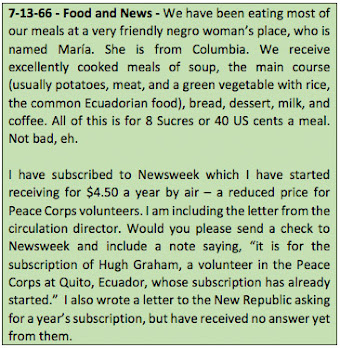 |
| 1966 Bus-Train passengers taking a lunch break and the view traveling on top | | |
|
Reading my 1966 description of the train ride from Guayaquil to Quito, I fear the image of the ugly American may come to mind. The reality, which I remember well, presents a different picture.
We were soon to be (we hoped) official Peace Corps Volunteers. On this train ride our minds were on more than the beautiful scenery passing by the windows. We were experiencing the anticipation and fear of a soon-to-be new period in our lives. Culminating all the difficulties of the recent months and the struggle navigating a different culture speaking another language, within the coming days we were to be "knighted" Volunteers or sent on our way to a future elsewhere. In the context, letting our hair down and enjoying a short-lived jubilant experience on a June day seems excusable.
Ferrocarril Transandino
Ecuador's rail system was started by President Gabriel García Moreno in 1861. It was devised to connect the Pacific coast with the
Andean highlands.
The push into the Andes was made under President Eloy Alfaro
who planned to link Quito in the highlands to Guayaquil on the coast of
Ecuador. For advice, Alfaro turned to Col. William Findlay Shunk, a
well-known North American engineer.
The Guayaquil and Quito railroad
line was built between 1897 and 1908. The line reached Quito amidst
celebration that lasted for days. Its completion shortened the often
lengthy trip from Quito to Guayaquil to two
days. Alfaro realized his dream of connecting the two most important
parts of Ecuador.
The railway was severely
damaged by heavy rainfall in 1997 and 1998 as well as from general neglect. In 2008 the president Rafael Correa named the railroad a "national cultural patrimony"
and indicated that it would be restored. The government of Ecuador
started to rehabilitate the railway and service was restored between
Guayaquil and Quito by 2013.
The Switch
 Our group trained to work with credit cooperatives in Ecuador. We completed initial training at Camp Crozier in the mountains of Puerto Rico. That training period is described in the first post. It lasted from March 4, 1966 to April 29, 1966.
Our group trained to work with credit cooperatives in Ecuador. We completed initial training at Camp Crozier in the mountains of Puerto Rico. That training period is described in the first post. It lasted from March 4, 1966 to April 29, 1966.
The final five weeks of training occurred in-country in Ecuador. This second period was split between two localities; (1) our prospective work site in Ecuador and (2) a final 10 days in Quito. If we succeeded, in Quito we would be officially enrolled as Peace Corps Volunteers.
It was during these last 10 days that I experienced the 'switch'. At some point I learned that I would be serving as a Volunteer working out of Quito, not Guayaquil.
The main reason, although probably not the only one, for this significant change was mentioned in my June 15, 1966 letter home. Two volunteer trainees who were expected to work in Quito had dropped out of the program and left the country. I was chosen by the Peace Corps Ecuador administrators to partially fill this gap.
We 22 remaining volunteers were
a significant reduction from the 30 candidates that arrived
for training at Camp Crozier in March 1966. As I
recall, at least one of those who left ended up in Vietnam. A number of
the others were able to find a place in postgraduate studies. I
contacted some of them about attending our first reunion in 2009, but
none responded.
























